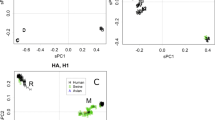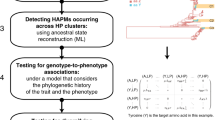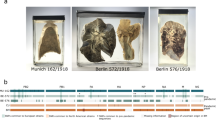Abstract
Arising from: J. K. Taubenberger et al. Nature 437, 889–893 (2005); see also communication from Gibbs and Gibbs; Taubenberger et al. reply
Taubenberger et al.1 claim that the 1918 influenza virus was derived from an avian source and adapted to humans shortly before the pandemic. However, we do not believe that this conclusion, which has been widely disseminated in the popular press and in scientific journals2,3,4, is supported by their phylogenetic evidence.
Similar content being viewed by others
Main
The authors' conclusion is based on DNA sequences from three RNA-polymerase genes, each of which resides on a separate RNA segment of the viral genome. The nucleotide phylogenies that they present1 show, with strong statistical support, that the 1918 influenza virus is found within clades containing human and classical swine influenza viruses and is not basal to those clades. Moreover, the relationship of the 1918 strain to avian strains (rather than to equine or other mammalian strains) is unresolved because the trees are unrooted.
The phylogenies described by Taubenberger et al.1 contradict their main conclusions and are presented without discussion of the evolutionary relationships they imply. Instead, evolutionary conclusions are improperly drawn from a similarity between the 1918 and avian influenza viruses in the patterns of base-pair substitution (that is, the synonymous/non-synonymous and transition/transversion ratios, and variation in fourfold-degenerate sites) and without consideration of the relative similarity of the 1918 flu in these traits to other mammalian strains. These are inappropriate characters from which to infer similarity by descent, and the data from the DNA sequences should not be discounted as they are superior indicators of phylogenetic relatedness.
Taubenberger et al.1 also claim that the amino-acid sequences encoded by these RNA-polymerase genes support the avian nature of the 1918 virus. We reconstructed phylogenies using their amino-acid sequences1 and found that the 1918 virus falls within, and not basal to, clades containing strains from other mammalian hosts (Fig. 1). Sequences from the nucleoprotein gene of the influenza virus also fail to provide evidence that the 1918 strain is derived directly from an avian source5.
a, b, Amino-acid alignments for a, PB1, and b, PB1-F2 (incomplete sequences omitted), taken from Supplementary Figure 2a, b of Taubenberger et al.1. Data were analysed using MEGA 3.1 software7; bootstrap values represent 100 replications. Sample names are given in ref. 1. The 1918 and avian viruses are shown in red and blue text, respectively.
In support of their conclusions, Taubenberger et al.1 cite prior phylogenetic studies6 indicating that the 1918 flu may have been derived from an avian source. However, those results simply show that the 1918 flu is phylogenetically unresolved and genetically equidistant from the North American and Asian clades of avian flu, which does not indicate emergence from an avian source.
By stating that the high pathogenicity of the 1918 virus is related to its emergence as a human-adapted avian influenza virus, the authors raise the possibility that an emerging avian strain could resemble the 1918 flu. This alarming implication, which is based on misinterpretation of the phylogenetic data, is completely unjustified and could seriously distort the public perception of disease risk, with grave economic and social consequences.
References
Taubenberger, J. K. et al. Nature 437, 889–893 (2005).
Belshe, R. B. N. Engl. J. Med. 353, 2209–2211 (2005).
Russell, C. J. & Webster, R. G. Cell 123, 368–371 (2005).
Sharp, P. A. Science 310, 17 (2005).
Reid, A. H., Fanning, T. G., Janczewski, T. A., Lourens, R. M. & Taubenberger, J. K. J. Virol. 78, 12462–12470 (2004).
Reid, A. H., Taubenberger, J. K. & Fanning, T. G. Nature Rev. Microbiol. 2, 909–914 (2004).
Kumar, S., Tamura, K. & Nei, M. Brief. Bioinformat. 5, 150–163 (2004).
Author information
Authors and Affiliations
Corresponding author
Rights and permissions
About this article
Cite this article
Antonovics, J., Hood, M. & Baker, C. Was the 1918 flu avian in origin?. Nature 440, E9 (2006). https://doi.org/10.1038/nature04824
Published:
Issue Date:
DOI: https://doi.org/10.1038/nature04824
This article is cited by
-
Cross-species virus transmission and its pandemic potential
Bulletin of the National Research Centre (2022)
-
Learnings from COVID-19 for managing humanitarian supply chains: systematic literature review and future research directions
Annals of Operations Research (2022)
-
Current situation of H9N2 subtype avian influenza in China
Veterinary Research (2017)
-
Detecting transmission and reassortment events for influenza A viruses with genotype profile method
Virology Journal (2011)
-
Das pandemische H1N1-Influenzavirus/2009
Bundesgesundheitsblatt - Gesundheitsforschung - Gesundheitsschutz (2010)
Comments
By submitting a comment you agree to abide by our Terms and Community Guidelines. If you find something abusive or that does not comply with our terms or guidelines please flag it as inappropriate.




